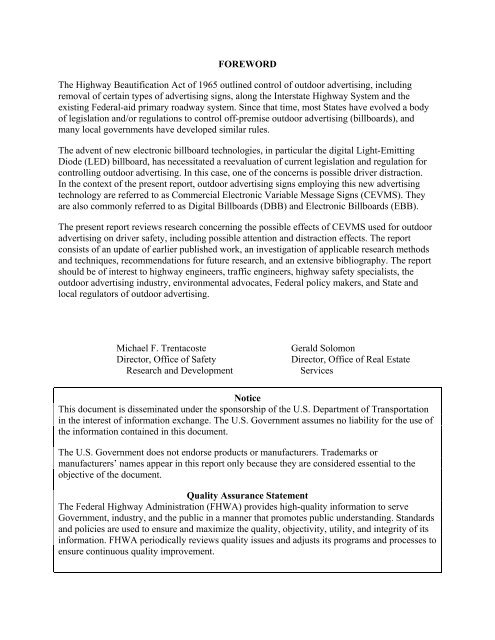The Effects of Commercial Electronic Variable Message Signs ...
The Effects of Commercial Electronic Variable Message Signs ...
The Effects of Commercial Electronic Variable Message Signs ...
Create successful ePaper yourself
Turn your PDF publications into a flip-book with our unique Google optimized e-Paper software.
FOREWORD<br />
<strong>The</strong> Highway Beautification Act <strong>of</strong> 1965 outlined control <strong>of</strong> outdoor advertising, including<br />
removal <strong>of</strong> certain types <strong>of</strong> advertising signs, along the Interstate Highway System and the<br />
existing Federal-aid primary roadway system. Since that time, most States have evolved a body<br />
<strong>of</strong> legislation and/or regulations to control <strong>of</strong>f-premise outdoor advertising (billboards), and<br />
many local governments have developed similar rules.<br />
<strong>The</strong> advent <strong>of</strong> new electronic billboard technologies, in particular the digital Light-Emitting<br />
Diode (LED) billboard, has necessitated a reevaluation <strong>of</strong> current legislation and regulation for<br />
controlling outdoor advertising. In this case, one <strong>of</strong> the concerns is possible driver distraction.<br />
In the context <strong>of</strong> the present report, outdoor advertising signs employing this new advertising<br />
technology are referred to as <strong>Commercial</strong> <strong>Electronic</strong> <strong>Variable</strong> <strong>Message</strong> <strong>Signs</strong> (CEVMS). <strong>The</strong>y<br />
are also commonly referred to as Digital Billboards (DBB) and <strong>Electronic</strong> Billboards (EBB).<br />
<strong>The</strong> present report reviews research concerning the possible effects <strong>of</strong> CEVMS used for outdoor<br />
advertising on driver safety, including possible attention and distraction effects. <strong>The</strong> report<br />
consists <strong>of</strong> an update <strong>of</strong> earlier published work, an investigation <strong>of</strong> applicable research methods<br />
and techniques, recommendations for future research, and an extensive bibliography. <strong>The</strong> report<br />
should be <strong>of</strong> interest to highway engineers, traffic engineers, highway safety specialists, the<br />
outdoor advertising industry, environmental advocates, Federal policy makers, and State and<br />
local regulators <strong>of</strong> outdoor advertising.<br />
Michael F. Trentacoste Gerald Solomon<br />
Director, Office <strong>of</strong> Safety Director, Office <strong>of</strong> Real Estate<br />
Research and Development Services<br />
Notice<br />
This document is disseminated under the sponsorship <strong>of</strong> the U.S. Department <strong>of</strong> Transportation<br />
in the interest <strong>of</strong> information exchange. <strong>The</strong> U.S. Government assumes no liability for the use <strong>of</strong><br />
the information contained in this document.<br />
<strong>The</strong> U.S. Government does not endorse products or manufacturers. Trademarks or<br />
manufacturers’ names appear in this report only because they are considered essential to the<br />
objective <strong>of</strong> the document.<br />
Quality Assurance Statement<br />
<strong>The</strong> Federal Highway Administration (FHWA) provides high-quality information to serve<br />
Government, industry, and the public in a manner that promotes public understanding. Standards<br />
and policies are used to ensure and maximize the quality, objectivity, utility, and integrity <strong>of</strong> its<br />
information. FHWA periodically reviews quality issues and adjusts its programs and processes to<br />
ensure continuous quality improvement.

















